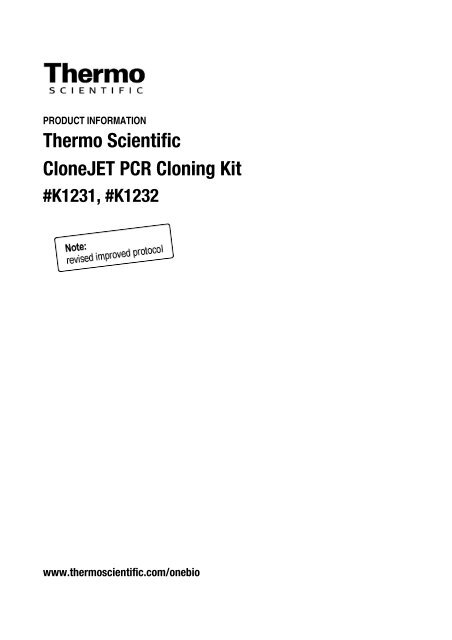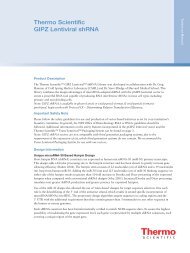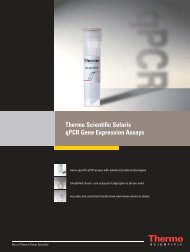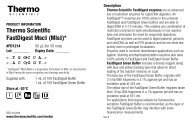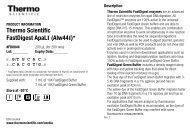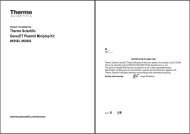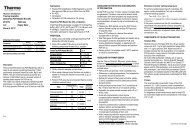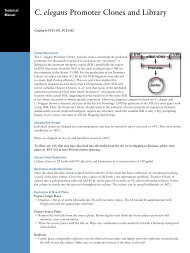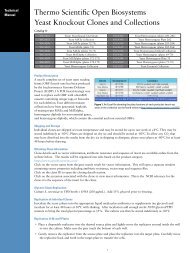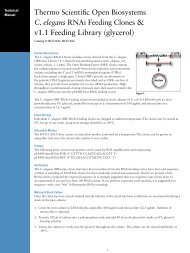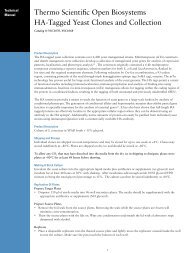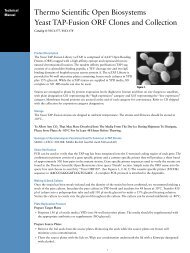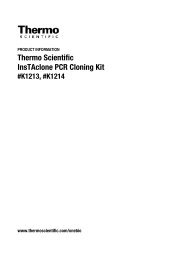CloneJET™ PCR Cloning Kit - Thermo Scientific
CloneJET™ PCR Cloning Kit - Thermo Scientific
CloneJET™ PCR Cloning Kit - Thermo Scientific
Create successful ePaper yourself
Turn your PDF publications into a flip-book with our unique Google optimized e-Paper software.
PRODUCT INFORMATION<br />
<strong>Thermo</strong> <strong>Scientific</strong><br />
CloneJET <strong>PCR</strong> <strong>Cloning</strong> <strong>Kit</strong><br />
#K1231, #K1232<br />
www.thermoscientific.com/onebio
#___<br />
Lot __<br />
Expiry Date __<br />
CERTIFICATE OF ANALYSIS<br />
All components of the kit were function tested in control experiment as described in the manual.<br />
A 2 µl aliquot of the ligation mixture was used to transform 50 µl of chemically competent XL1-Blue<br />
cells of >106 cfu/µg DNA transformation efficiency.<br />
<strong>Cloning</strong> efficiency of the Control <strong>PCR</strong> Product into the pJET1.2/blunt was >2x104 cfu/µg DNA.<br />
>90% of the recombinant plasmids contained the appropriate insert.<br />
Quality authorized by: Jurgita Zilinskiene<br />
Rev.10. }" N~
CONTENTS page<br />
COMPONENTS OF THE KIT ................................................................. 2<br />
STORAGE ............................................................................................ 2<br />
DESCRIPTION ....................................................................................... 2<br />
CLONING PRINCIPLE ........................................................................... 2<br />
IMPORTANT NOTES ............................................................................. 3<br />
CONSIDERATIONS FOR CLONING LONG <strong>PCR</strong> PRODUCTS ............. 4<br />
CLONING PROTOCOLS ....................................................................... 5<br />
Blunt-End <strong>Cloning</strong> Protocol .............................................................. 5<br />
Sticky-End <strong>Cloning</strong> Protocol ............................................................ 6<br />
Transformation ................................................................................ 7<br />
Analysis of recombinant clones ....................................................... 8<br />
CONTROL CLONING EXPERIMENT .................................................... 9<br />
MAP AND FEATURES OF pJET1.2/blunt CLONING VECTOR ........... 10<br />
RECIPES & SUPPLEMENTARY PROTOCOLS .................................. 12<br />
TROUBLESHOOTING ......................................................................... 13<br />
1
COMPONENTS OF THE KIT<br />
CloneJET <strong>PCR</strong> <strong>Cloning</strong> <strong>Kit</strong><br />
20 cloning reactions<br />
#K1231<br />
40 cloning reactions<br />
#K1232<br />
pJET1.2/blunt <strong>Cloning</strong> Vector (50 ng/µl) 24 µl 46 µl<br />
2X Reaction Buffer 300 µl 600 µl<br />
T4 DNA Ligase (5 u/µl) 24 µl 46 µl<br />
DNA Blunting Enzyme 24 µl 46 µl<br />
pJET1.2 Forward Sequencing Primer,<br />
10 µM aqueous solution<br />
50 µl 100 µl<br />
pJET1.2 Reverse Sequencing Primer,<br />
10 µM aqueous solution<br />
50 µl 100 µl<br />
Control <strong>PCR</strong> Product (24 ng/µl)<br />
976 bp, with 3’-dA overhangs<br />
8 µl 12 µl<br />
Water, nuclease-free 1.25 ml 1.25 ml<br />
STORAGE<br />
All components of the <strong>Thermo</strong> <strong>Scientific</strong> CloneJET <strong>PCR</strong> <strong>Cloning</strong> <strong>Kit</strong> should be stored at -20°C.<br />
DESCRIPTION<br />
The CloneJET <strong>PCR</strong> <strong>Cloning</strong> <strong>Kit</strong> is an advanced positive selection system for the highest<br />
efficiency cloning of <strong>PCR</strong> products generated with Pfu DNA polymerase, Taq DNA<br />
polymerase, <strong>Thermo</strong> <strong>Scientific</strong> DreamTaq DNA polymerase or other thermostable DNA<br />
polymerases. Additionally, any other DNA fragment, either blunt or sticky-end, can be<br />
successfully cloned using the kit.<br />
The kit features the novel positive selection cloning vector pJET1.2/blunt. This vector contains<br />
a lethal gene which is disrupted by ligation of a DNA insert into the cloning site. As a result,<br />
only cells with recombinant plasmids are able to propagate, eliminating the need for expensive<br />
blue/white screening.<br />
The vector contains an expanded multiple cloning site, as well as a T7 promoter for in vitro<br />
transcription. Sequencing primers are included for convenient sequencing of the cloned insert.<br />
CLONING PRINCIPLE<br />
pJET1.2/blunt is a linearized cloning vector, which accepts inserts from 6 bp to 10 kb. The<br />
5'-ends of the vector cloning site contain phosphoryl groups, therefore, phosphorylation of the<br />
<strong>PCR</strong> primers is not required.<br />
Blunt-end <strong>PCR</strong> products generated by proofreading DNA polymerases can be directly ligated<br />
in just 5 min with the pJET1.2/blunt cloning vector. <strong>PCR</strong> products with 3’-dA overhangs<br />
generated using Taq DNA polymerase or other non-proofreading thermostable DNA<br />
polymerases are blunted in 5 min with a proprietary thermostable DNA blunting enzyme<br />
(included in the kit) prior to ligation. All common laboratory E.coli strains can be directly<br />
transformed with the ligation product.<br />
Recircularized pJET1.2/blunt vector expresses a lethal restriction enzyme after transformation<br />
and is not propagated. As a result, only recombinant clones containing the insert appear on<br />
culture plates. Therefore, blue/white screening is not required.<br />
2
IMPORTANT NOTES<br />
• Thoroughly mix every vial before use.<br />
• The CloneJET <strong>PCR</strong> <strong>Cloning</strong> <strong>Kit</strong> is compatible with all <strong>PCR</strong> buffers supplied by <strong>Thermo</strong><br />
<strong>Scientific</strong>.<br />
• Gel-analyze the <strong>PCR</strong> product for specificity and yield before cloning.<br />
• Specific <strong>PCR</strong> products of
CONSIDERATIONS FOR CLONING LONG <strong>PCR</strong> PRODUCTS<br />
Short DNA fragments (3 kb. Ligation times longer than 30 min are<br />
not recommended and may decrease cloning efficiency.<br />
• Use competent E.coli cells of high transformation efficiency (see p 5. Transformation)<br />
• Success in cloning of long <strong>PCR</strong> products may also depend on the DNA sequence of the<br />
insert. <strong>PCR</strong> products may contain toxic sequences not tolerated by E.coli, therefore<br />
multicopy vectors like pJET1.2 may not be suitable cloning these <strong>PCR</strong> products.<br />
4
Blunt-End <strong>Cloning</strong> Protocol<br />
CLONING PROTOCOLS<br />
• For cloning blunt-end <strong>PCR</strong> products generated by proofreading DNA polymerases,<br />
such as Pfu DNA polymerase. (If the DNA end structure of the <strong>PCR</strong> products is not<br />
specified by the supplier of the DNA polymerase, follow the Sticky-End <strong>Cloning</strong> Protocol on<br />
page 6).<br />
• For cloning of blunt-end DNA fragments generated by restriction enzyme digestion.<br />
Gel-purify the DNA fragment prior to ligation and use in a 3:1 molar ratio with pJET1.2/blunt<br />
(see Table 1).<br />
1. Set up the ligation reaction on ice:<br />
Component Volume<br />
2X Reaction Buffer 10 µl<br />
Non-purified <strong>PCR</strong> product<br />
or<br />
1 µl<br />
purified <strong>PCR</strong> product/other blunt-end DNA fragment 0.15 pmol ends<br />
pJET1.2/blunt <strong>Cloning</strong> Vector (50 ng/µl) 1 µl (0.05 pmol ends)<br />
Water, nuclease-free up to 19 µl<br />
T4 DNA Ligase 1 µl<br />
Total volume 20 µl<br />
Vortex briefly and centrifuge for 3-5 s.<br />
2. Incubate the ligation mixture at room temperature (22°C) for 5 min.<br />
Note. For <strong>PCR</strong> products >3 kb, ligation can be prolonged to 30 min. Ligation times longer than 30 min are<br />
not recommended and may decrease cloning efficiency.<br />
3. Use the ligation mixture directly for transformation (see page 7 for Transformation).<br />
Note. Keep the ligation mixture at -20°C if transformation is postponed. Thaw on ice and mix carefully<br />
before transformation.<br />
5
Sticky-End <strong>Cloning</strong> Protocol<br />
• For cloning <strong>PCR</strong> products with 3'-dA overhangs generated by Taq DNA polymerase,<br />
DreamTaq DNA polymerase or enzyme mixtures containing Taq DNA polymerase.<br />
• For cloning <strong>PCR</strong> products when DNA end structure of the generated <strong>PCR</strong> products is not<br />
specified by the supplier of the DNA polymerase.<br />
• For cloning DNA fragments with 5’- or 3’-overhangs generated by restriction enzyme<br />
digestion. Gel-purify the DNA fragment prior to ligation and use in a 3:1 molar ratio with<br />
pJET1.2/blunt (see Table 1).<br />
Note. The DNA Blunting Enzyme is a proprietary thermostable DNA polymerase with proofreading activity. It<br />
will remove 3'- overhangs and fill-in 5'-overhangs. Nucleotides for the blunting reaction are included in the<br />
reaction buffer.<br />
1. Set up the blunting reaction on ice:<br />
Component Volume<br />
2X Reaction Buffer 10 µl<br />
Non-purified <strong>PCR</strong> product<br />
or<br />
purified <strong>PCR</strong> product/other sticky-end DNA fragment<br />
6<br />
1 µl<br />
0.15 pmol ends<br />
Water, nuclease-free to 17 µl<br />
DNA Blunting Enzyme 1 µl<br />
Total volume 18 µl<br />
Vortex briefly and centrifuge for 3-5 s.<br />
2. Incubate the mixture at 70°C for 5 min. Chill on ice.<br />
3. Set up the ligation reaction on ice. Add the following to the blunting reaction mixture:<br />
Component Volume<br />
pJET1.2/blunt <strong>Cloning</strong> Vector (50 ng/µl)<br />
1 µl<br />
(0.05 pmol ends)<br />
T4 DNA Ligase 1 µl<br />
Total volume 20 µl<br />
Vortex briefly and centrifuge for 3-5 s to collect drops.<br />
4. Incubate the ligation mixture at room temperature (22°C) for 5 min.<br />
Note. For <strong>PCR</strong> products >3 kb, ligation can be prolonged to 30 min. Ligation times longer than 30 min are<br />
not recommended and may decrease cloning efficiency.<br />
5. Use the ligation mixture directly for transformation (see page 7 for Transformation).<br />
Note. Keep the ligation mixture at -20 o C if transformation is postponed. Thaw on ice and mix carefully<br />
before transformation.
Transformation<br />
• The CloneJET <strong>PCR</strong> <strong>Cloning</strong> <strong>Kit</strong> is compatible with all common E.coli laboratory strains.<br />
Transformation of competent E.coli cells with the ligation mixture can be performed using<br />
different transformation methods (Table 2 and 3).<br />
• The number of transformants on the plates directly depends on the transformation efficiency<br />
of the competent cells.<br />
• For successful cloning, competent E.coli cells should have an efficiency of at least 1x10 6 cfu/ µg<br />
supercoiled plasmid DNA. To check the efficiency, prepare a control transformation with 0.1 ng<br />
of a supercoiled vector DNA, e.g., pUC19 DNA, #SD0061 (Table 2).<br />
Table 2. Evaluation of transformation efficiency of competent cells (control transformation).<br />
Transformation<br />
method<br />
<strong>Thermo</strong> <strong>Scientific</strong><br />
TransformAid Bacterial<br />
Transformation <strong>Kit</strong><br />
(#K2710)*<br />
Calcium chloride<br />
transformation<br />
Number of<br />
transformants per<br />
µg of supercoiled<br />
plasmid DNA<br />
7<br />
Amount of pUC19 DNA for<br />
control transformation<br />
(to yield ~ 1000 colonies<br />
per plate)<br />
Volume of<br />
competent<br />
cells<br />
~1x10 7 0.1ng 50 µl<br />
~1x10 6 1ng 50 µl<br />
Electro-transformation ~1x10 9 0.01 ng 40 µl<br />
* XL1-Blue, ER2267, ER1727 E. coli strains are the best strains for transformation with TransformAid <br />
Bacterial Transformation <strong>Kit</strong>. DH10B, DH5α and TOP10 strains are not efficient with TransformAid but are<br />
recommended for calcium chloride transformation or electroporation.<br />
• For transformation of the ligation mixture, refer to Table 3.<br />
Table 3. Recommendations for transformation of ligation mixture.<br />
Tranformation<br />
method<br />
TransformAid<br />
Bacterial<br />
Transformation<br />
<strong>Kit</strong> (#K2710)<br />
Calcium<br />
Chloride<br />
Transformation<br />
Electrotransformation<br />
Treatment of the<br />
ligation mixture before<br />
transformation<br />
Volume of the<br />
ligation mixture for<br />
transformation<br />
Volume of<br />
competent cells for<br />
transformation<br />
Not necessary ≤2.5 µl 50 µl<br />
Not necessary ≤5 µl 50 µl<br />
Spin column (GeneJET<br />
<strong>PCR</strong> Purification <strong>Kit</strong>,<br />
#K0701) or chloroform<br />
extraction<br />
(see protocol on p. 11)<br />
1 µl of purified<br />
ligation mixture<br />
40 µl
Analysis of recombinant clones<br />
Analyze 4-6 colonies for the presence and orientation of the DNA insert using one of the<br />
following methods:<br />
Colony <strong>PCR</strong><br />
Use the following protocol for colony screening by <strong>PCR</strong> if the cloned <strong>PCR</strong> fragment is shorter<br />
than 3kb. For longer inserts, perform restriction analysis.<br />
1. Prepare enough <strong>PCR</strong> master mix for the number of colonies analyzed plus one extra. For<br />
each 20 µl reaction, mix the following reagents:<br />
Component<br />
8<br />
Using Taq DNA<br />
Polymerase<br />
Using 2X <strong>PCR</strong><br />
Master Mix<br />
10X Taq buffer 2.0 µl –<br />
dNTP mix, 2 mM each 2.0 µl –<br />
25 mM MgCl2 1.2 µl –<br />
pJET1.2 Forward Sequencing Primer, 10 µM 0.4 µl 0.4 µl<br />
pJET1.2 Reverse Sequencing Primer, 10 µM 0.4 µl 0.4 µl<br />
Water, nuclease-free<br />
Taq DNA Polymerase 5 u/µl, #EP0401<br />
13.9 µl 9.2 µl<br />
or<br />
DreamTaq Green DNA Polymerase, #EP0711<br />
<strong>PCR</strong> Master Mix (2X), #K0171<br />
0.1 µl –<br />
or<br />
DreamTaq Green <strong>PCR</strong> Master Mix (2X), #K1081<br />
– 10 µl<br />
Total volume 20 µl 20 µl<br />
2. Mix well. Aliquot 20 µl of the mix into the <strong>PCR</strong> tubes on ice.<br />
3. Pick an individual colony and resuspend in 20 µl of the <strong>PCR</strong> master mix.<br />
4. Perform <strong>PCR</strong>: 95°C, 3 min; 94°C, 30 s, 60°C, 30 s, 72°C 1 min/kb; 25 cycles.<br />
5. Analyze on an agarose gel for the presence of the <strong>PCR</strong> product.<br />
Note<br />
Due to considerable amount of recircularised vector plated on the surface of plate, colony <strong>PCR</strong> may give some<br />
false-negative results. Prior to clone analysis propagate short strikes of individual colonies on ampicillin plates.<br />
Then use small amount of each for colony <strong>PCR</strong>.<br />
Restriction analysis<br />
Isolate plasmid DNA from an overnight bacterial culture. To speed up the process and to<br />
assure the quality of purified plasmid DNA, use the GeneJET Plasmid Miniprep <strong>Kit</strong> (#K0503).<br />
To digest DNA from recombinant clones in just 5 minutes, use <strong>Thermo</strong> <strong>Scientific</strong> FastDigest<br />
restriction enzymes.<br />
Sequencing<br />
Use the pJET1.2 Forward Sequencing Primer or pJET1.2 Reverse Sequencing Primer<br />
supplied with the kit to sequence the cloned insert. See page 11 for primer sequences.
CONTROL CLONING EXPERIMENT<br />
The control reaction should be used to verify the efficiency of the blunting and ligation steps.<br />
The 976 bp control <strong>PCR</strong> product (nucleotide sequence is available at<br />
www.thermoscientific.com/onebio) has been generated with Taq DNA polymerase, which adds<br />
extra nucleotides to the 3'-end. Therefore, the Sticky-End Protocol must be followed.<br />
1. Set up the blunting reaction on ice:<br />
Component Volume<br />
2X Reaction Buffer 10 µl<br />
Control <strong>PCR</strong> Product (24 ng/µl) 2 µl<br />
Water, nuclease-free 5 µl<br />
DNA Blunting Enzyme 1 µl<br />
Total volume 18 µl<br />
Vortex briefly and centrifuge for 3-5 s to collect drops.<br />
2. Incubate the mixture at 70°C for 5 min. Chill on ice.<br />
3. Set up the ligation reaction on ice. Add the following to the blunting reaction mixture:<br />
Component Volume<br />
pJET1.2/blunt <strong>Cloning</strong> Vector (50 ng/µl) 1 µl<br />
T4 DNA Ligase 1 µl<br />
Total volume 20 µl<br />
Vortex briefly and centrifuge for 3-5 s to collect drops.<br />
4. Incubate the ligation mixture at room temperature (22°C) for 5 min.<br />
5. Use the ligation mixture directly for transformation (see page 7 for Transformation). Keep<br />
the ligation mixture at -20°C if transformation is postponed. Thaw on ice and mix carefully<br />
before transformation.<br />
Analyze colonies by colony <strong>PCR</strong> (see page 8). At least 9 of 10 analyzed colonies should<br />
contain recombinant plasmid with the 976 bp insert.<br />
The number of transformants depends on the transformation efficiency of the E. coli cells.<br />
Verify the transformation efficiency by transforming supercoiled plasmid, e.g., pUC19 DNA<br />
(#SD0061) in parallel. Refer to page 7 Table 2 for correct control transformations.<br />
9
MAP AND FEATURES OF pJET1.2/blunt CLONING VECTOR<br />
The pJET1.2/blunt cloning vector has been linearized with Eco32I (EcoRV) (GenBank/EMBL<br />
Accession number EF694056). The blunt ends of the vector contain 5'-phosphoryl groups. The<br />
nucleotide sequence of pJET1.2/blunt is available at www.thermoscientific.com/onebio<br />
Fig. 1. pJET1.2/blunt Vector Map.<br />
Fig. 2. DNA Sequence of MCS region.<br />
10
Genetic elements of the pJET1.2/blunt cloning vector<br />
Element Function Position (bp)<br />
rep (pMB1) Replicon (rep) from the pMBI plasmid<br />
responsible for the replication of pJET1.2<br />
11<br />
1762-1148<br />
Replication start Initiation of replication 1162±1<br />
bla (Ap R) β-lactamase gene conferring resistance to<br />
ampicillin. Used for selection and maintenance<br />
of recombinant E.coli cells<br />
eco47IR Lethal gene eco47IR enables positive selection<br />
of recombinant plasmid<br />
PlacUV5<br />
Modified Plac promoter for expression of the<br />
eco47IR gene at a level sufficient to allow for<br />
positive selection<br />
T7 promoter T7 RNA polymerase promoter for in vitro<br />
transcription of the cloned insert<br />
Multiple cloning site<br />
(MCS)<br />
Mapping, screening and excision of the cloned<br />
insert<br />
2782-1922<br />
753-16<br />
892-769<br />
305-324<br />
422-328<br />
Insertion site Blunt DNA ends for ligation with insert 371-372<br />
Primer binding sites:<br />
pJET1.2 forward<br />
sequencing primer<br />
pJET1.2 reverse<br />
sequencing primer<br />
Primer sequences<br />
Sequencing of insert, colony <strong>PCR</strong><br />
Sequencing of insert, colony <strong>PCR</strong><br />
310-332<br />
428-405<br />
pJET1.2 forward sequencing primer, 23-mer 5’-CGACTCACTATAGGGAGAGCGGC-3’<br />
pJET1.2 reverse sequencing primer, 24-mer 5’-AAGAACATCGATTTTCCATGGCAG-3’<br />
Fermentas restriction enzymes that do not cut pJET1.2/blunt<br />
For complete list of enzymes see www.thermoscientific.com/reviewer.<br />
AarI, Acc65I, AjiI, AjuI, AlfI, ApaI, BamHI, BclI, BcuI, BoxI, BplI, Bpu1102I, BseJI, BshTI,<br />
Bsp119I, Bsp120I, Bsp1407I, Bsp68I, BspTI, Bst1107I, BstXI, Cfr42I, Cfr9I, CpoI, Ecl136II,<br />
Eco105I, Eco147I, Eco24I, Eco32I, Eco47III, Eco72I, Eco81I, Eco91I, EcoO109I, EcoRI,<br />
EheI, FspAI, HincII, KpnI, KspAI, MlsI, MluI, Mph1103I, NdeI, NheI, OliI, PaeI, PasI, PauI,<br />
PdiI, Pfl23II, PfoI, Ppu21I, Psp5II, PsyI, SacI, SalI, SdaI, SfiI, SgsI, SmaI, TstI, Van91I, XagI,<br />
XmaJI, XmiI.
Fermentas restriction enzymes that cut pJET1.2/blunt once<br />
For complete list of enzymes see www.thermoscientific.com/reviewer.<br />
Enzyme Location Enzyme Location Enzyme Location<br />
AasI 1204 Eco130I 408 NcoI 408<br />
AdeI 120 Eco31I 2062 NotI 328<br />
AloI 284 Eco52I 329 NsbI 2215<br />
BfiI 2040 Eco88I 352 PdmI 2590<br />
BglI 2109 Esp3I 739 PstI 5<br />
BpiI 58 FaqI 103 PvuI 2362<br />
Bpu10I 717 GsuI 2080 RsaI 2474<br />
Bsu15I 417 HindIII 624 ScaI 2473<br />
BveI 219 Kpn2I 343 SmuI 951<br />
CaiI 1513 LguI 979 TatI 2473<br />
Cfr10I 2075 MssI 761 XbaI 377<br />
Csp6I 2474 MunI 892 XhoI 352<br />
Eam1105I 1990 Mva1269I 722<br />
RECIPES & SUPPLEMENTARY PROTOCOLS<br />
Chloroform extraction of the ligation mixture prior electroporation<br />
1. Add an equal volume (20 µl) of the chloroform to the ligation mixture. Mix well.<br />
2. Centrifuge at 10,000 rpm for 3 min at room temperature.<br />
3. Carefully transfer the upper aqueous phase to a fresh tube.<br />
4. Use 1 µl of the purified mixture for transformation of 40 µl of electrocompetent cells.<br />
Keep the purified ligation mixture at -20°C if transformation is postponed. Thaw on ice and mix<br />
carefully before transformation.<br />
Ampicillin stock solution (50 mg/ml)<br />
1. Dissolve 2.5 g ampicillin sodium salt in 50 ml of deionized water.<br />
2. Filter sterilize and store in aliquots at 4°C.<br />
LB-ampicillin plates<br />
1. Prepare LB-agar Medium (1 liter), weigh out:<br />
Bacto ® Tryptone 10 g,<br />
Bacto Yeast extract 5 g,<br />
NaCl 5 g.<br />
2. Dissolve in 800 ml of water, adjust pH to 7.0 with NaOH and add water to 1000 ml.<br />
3. Add 15 g of agar and autoclave.<br />
4. Allow the medium to cool to 55°C.<br />
5. Add 2 ml of ampicillin stock solution (50 mg/ml) to a final concentration of 100 µg/ml.<br />
6. Mix gently and pour plates.<br />
For fast and easy preparation of LB medium and LB agar plates supplemented with ampicillin,<br />
use pre-mixed and pre-sterilized microwaveable <strong>Thermo</strong> <strong>Scientific</strong> FastMedia LB Liquid Amp<br />
(#M0011) and FastMedia LB Agar Amp (#M0021).<br />
12
Problem Cause and Solution<br />
Few or no<br />
transformants<br />
TROUBLESHOOTING<br />
Low transformation efficiency of competent E. coli cells.<br />
Verify transformation efficiency with supercoiled plasmid DNA (e.g.,<br />
pUC19). Refer to page 7 Table 2 for control transformations.<br />
Ligation mixture was not purified prior to electroporation.<br />
Always column-purify the ligation mixture using e.g. GeneJET <strong>PCR</strong><br />
Purification <strong>Kit</strong>, #K0701 or chloroform extract it prior to<br />
electroporation (see protocol on p. 12). Electroporation is inhibited by<br />
the presence of proteins and salts in the mixture. This can cause not<br />
only low transformation efficiency, but also arcing of the sample<br />
during electroporation<br />
Incorrect protocol was used.<br />
If Taq DNA polymerase or any enzyme mix containing Taq DNA<br />
polymerase was used for <strong>PCR</strong>, always follow the Sticky-End Protocol<br />
to blunt the <strong>PCR</strong> product prior to ligation.<br />
T4 DNA Ligase was inhibited by salts present in the <strong>PCR</strong> buffer.<br />
Do not use more than 1 µl of the <strong>PCR</strong> mixture in the ligation reaction<br />
to avoid inhibition of T4 DNA ligase by salts.<br />
<strong>PCR</strong> product was damaged by UV light during excision from the<br />
agarose gel.<br />
Use a long wavelength UV (360 nm) light-box when excising DNA<br />
from the agarose gel. When using a short-wavelength (254-312 nm)<br />
light-box, limit DNA exposure to UV to a few seconds. Keep the gel<br />
on a glass plate or on a plastic plate during UV illumination.<br />
Alternatively, use dyes, like crystal violet, to visualize DNA in ambient<br />
light (1, 2).<br />
Cloned sequence is not tolerated by E.coli.<br />
Check the target sequence for strong E.coli promoters or other<br />
potentially toxic elements, as well as inverted repeats. In cases where<br />
the product of a cloned gene is toxic to the host, use promoters with a<br />
very low expression background, choose a low copy plasmid as<br />
cloning vehicle or change the host.<br />
Incorrect insert/vector ratio used for ligation<br />
The kit performs well over a wide range of insert/vector molar ratios<br />
(0.5:1 to 15:1). The optimal insert/vector ratio is 3:1. To calculate<br />
optimal amount of the <strong>PCR</strong> product for ligation, refer to a Table 1 on<br />
p. 4 or use dedicated software (like<br />
www.thermoscientific.com/reviewer) for calculations.<br />
13
Problem Cause and Solution<br />
Background<br />
colonies without<br />
plasmid<br />
Background<br />
colonies that<br />
contain plasmids<br />
with incorrect<br />
inserts<br />
Background<br />
colonies that<br />
contain plasmids<br />
without inserts<br />
Insufficient amount of antibiotic in agar medium.<br />
Use 100 µg/ml of ampicillin in LB-ampicillin agar plates. Allow the LB<br />
medium to cool to 55°C before addition of the ampicillin.<br />
<strong>PCR</strong> products are contaminated with a template which encodes<br />
ampicillin resistance.<br />
Gel-purify the <strong>PCR</strong> product if the <strong>PCR</strong> template encodes a<br />
β-lactamase to avoid background colonies on LB-ampicillin agar.<br />
Non-specific <strong>PCR</strong> products or primer dimers were cloned<br />
into pJET1.2/blunt.<br />
Gel-analyze the <strong>PCR</strong> product prior to ligation with the pJET1.2/blunt.<br />
If non-specific <strong>PCR</strong> products or primer-dimers were generated during<br />
the <strong>PCR</strong> reaction, gel-purify the target <strong>PCR</strong> product. Otherwise,<br />
optimize the <strong>PCR</strong> conditions to increase specificity.<br />
Short DNA fragments (
Problem Cause and Solution<br />
Sequence errors<br />
in the cloned<br />
insert<br />
<strong>PCR</strong> product was damaged by UV light during excision from<br />
agarose gel.<br />
Use a long wavelength UV (360 nm) light-box when excising DNA<br />
from the agarose gel. When a short-wavelength (254-312 nm)<br />
light-box is used, limit DNA exposure to UV to a few seconds. Keep<br />
the gel on a glass or on plastic plate during UV illumination.<br />
Alternatively, use dyes visible in ambient light to visualize DNA in<br />
standard agarose gels (1, 2).<br />
Low fidelity DNA polymerase was used in <strong>PCR</strong>.<br />
If <strong>PCR</strong> product will be used for cloning it is always recommended to<br />
use high fidelity DNA polymerase with proofreading activity, such as<br />
Pfu DNA Polymerase (#EP0671) or High Fidelity <strong>PCR</strong> Enzyme Mix<br />
(#K0191). Follow recommendations for high fidelity <strong>PCR</strong> (adjust<br />
concentration of magnesium chloride and other parameters).<br />
Errors in <strong>PCR</strong> primers.<br />
If the cloned <strong>PCR</strong> product contains sequence errors or is missing 5’<br />
bases and the same error persists in more than one clone, re-order<br />
the <strong>PCR</strong> primers from a reliable supplier and repeat the procedure<br />
starting from the <strong>PCR</strong> step.<br />
15
References<br />
1. Rand, K.N., Crystal Violet can be used to Visualize DNA Bands during Gel Electrophoresis<br />
and to Improve <strong>Cloning</strong> Efficiency, Elsevier Trends Journals Technical Tips, Online,<br />
T40022, 1996.<br />
2. Adkins, S., Burmeister, M., Visualization of DNA in agarose gels and educational<br />
demonstrations, Anal Biochem., 240 (1), 17-23, 1996.<br />
NOTICES<br />
• The purchase price of this product includes a limited, non-transferable license under national patents from<br />
EP 0 547 920 B1, owned by New England Biolabs, Inc., to use this product. No other license under these<br />
patents is conveyed expressly or by implication to the purchaser by the purchase of this product.<br />
• Use of this product is covered by US Patent No. 6,127,155. The purchase of this product includes a limited,<br />
non-transferable immunity from suit under the foregoing patent claims for using only this amount of product<br />
for the purchaser’s own internal research. No right under any other patent claim, no right to perform any<br />
patented method and no right to perform commercial services of any kind, including without limitation<br />
reporting the results of purchaser's activities for a fee or other commercial consideration, is conveyed<br />
expressly, by implication, or by estoppel. This product is for research use only. Diagnostic uses under<br />
Roche patents require a separate license from Roche. Further information on purchasing licenses may be<br />
obtained by contacting the Director of Licensing, Applied Biosystems, 850 Lincoln Centre Drive, Foster<br />
City, California<br />
• This product or the use of this product is covered by US patent application US20090042249A1 and<br />
corresponding counterparts.<br />
PRODUCT USE LIMITATION<br />
This product is developed, designed and sold exclusively for research purposes and in vitro use only. The<br />
product was not tested for use in diagnostics or for drug development, nor is it suitable for administration to<br />
humans or animals.<br />
Please refer to www.thermoscientific.com/onebio for Material Safety Data Sheet of the product.<br />
© 2012 <strong>Thermo</strong> Fisher <strong>Scientific</strong> Inc. All rights reserved. Bacto is a registered trademark of Difco Laboratories.<br />
All other trademarks are the property of <strong>Thermo</strong> Fisher <strong>Scientific</strong> Inc. and its subsidiaries.<br />
16


